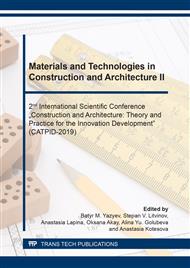[1]
M.Yu. Kvasnikov, O.A. Romanova, A.V. Pavlov, A.A. Silaeva, Ko Ko Lwin, Nanostructured Metal–Polymer Paint Coatings, Nanotechnologies in Russia. 13 (1-2) (2018) 61-66.
DOI: 10.1134/s1995078018010056
Google Scholar
[2]
R.S. Fediuk, Mechanical activation of construction binder materials by various mills, IOP Conf. Series: Materials Science and Engineering. 125 (2016) 012019.
DOI: 10.1088/1757-899x/125/1/012019
Google Scholar
[3]
J.A. García, A. Martínez, B. Lerga, M. Rico, G.G. Fuentes, M. Zazpe, R.J. Rodríguez, Decorative coatings by PVD on ceramics, Boletin de la Sociedad Espanola de Ceramica y Vidrio. 45 (4) (2006) 255-258.
DOI: 10.3989/cyv.2006.v45.i4.281
Google Scholar
[4]
R.S. Fediuk, High-strength fibrous concrete of Russian Far East natural materials, IOP Conf. Series: Materials Science and Engineering. 116 (2016) 012020.
DOI: 10.1088/1757-899x/116/1/012020
Google Scholar
[5]
M.A. Garrido, P.V. Paulo, F.A. Branco, Service life prediction of façade paint coatings in old buildings, Constr. Build. Mater. 29 (2012) 394-402.
DOI: 10.1016/j.conbuildmat.2011.10.057
Google Scholar
[6]
V.I. Loganina, J.P. Skachkov, T.V. Uchaeva, Assessment of the Stability of the Staining Process of Building Products and Constructions, International Journal of Applied Engineering Research. 11 (19) (2016) 9727-9729.
Google Scholar
[7]
T.Y.Lo, W.Liao, C.K. Wong, W.Tang, Evaluation of carbonation resistance of paint coated concrete for buildings, Constr. Build. Mater. 107 (2016) 299-306.
DOI: 10.1016/j.conbuildmat.2016.01.026
Google Scholar
[8]
V.I. Loganina, V.G. Kamburg, L.V. Makarova, N.Yu. Bododkov, Method of Building Optimization of Composites Based on the Criterion Analysis, Contemporary Engineering Science. 7 (2014) 1555-1563.
DOI: 10.12988/ces.2014.410188
Google Scholar
[9]
S.Chen, L. Jiang, L. Wu, Y. Wang, A. Usmani, Damage investigation of cementitious fire resistive coatings under complex loading, Constr. Build. Mater. 204 (2019) 659-674.
DOI: 10.1016/j.conbuildmat.2018.12.217
Google Scholar
[10]
V.I. Loganina, T.O. Kruglova, A question on a reliability of control during a concrete manufacruring, International Journal of Management, Information Technology and Engineering, 12 (1) (2014) 79-82.
Google Scholar
[11]
Z.P. Deng, X. Huang, H.W. Xing, On-line calibration and uncertainties evaluation of spherical joint positions on large aircraft component for zero-clearance posture alignment, Robotics and computer-integrated manufacturing. 56 (2019) 38-54.
DOI: 10.1016/j.rcim.2018.07.016
Google Scholar
[12]
V.I. Loganina, B.B. Khrustaleva, T.V. Uchaeva, Statistical management of the production of the building products, Eastern European Journal of Advanced Technologies. 1 (3) (2013) 65-67.
Google Scholar
[13]
W.J. Yan, L.S. Katafygiotis, An analytical investigation into the propagation properties of uncertainty in a two-stage fast Bayesian spectral density approach for ambient modal analysis, Mechanical systems and signal processing. 118 (2019) 503-533.
DOI: 10.1016/j.ymssp.2018.08.047
Google Scholar
[14]
R.S. Fediuk, A.M. Yushin, Composite binders for concrete with reduced permeability, IOP Conf. Series: Materials Science and Engineering, 116 (2016) 012021.
DOI: 10.1088/1757-899x/116/1/012021
Google Scholar
[15]
F.Gregis, On the meaning of measurement uncertainty, Measurement. 133 (2019) 41-46.
Google Scholar
[16]
C.Palma, V. Morgado, R. da Silva, Top-down evaluation of matrix effects uncertainty, Talanta. 192 (2019) 278-287.
DOI: 10.1016/j.talanta.2018.09.039
Google Scholar
[17]
V.I. Loganina, E.I. Kuimova, T.V. Uchaeva, Application of the Method of Multivariate Analysis to Assess the Quality of Coatings, Contemporary Engineering Sciences. 7 (35) (2014) 1853-1859.
DOI: 10.12988/ces.2014.410200
Google Scholar


